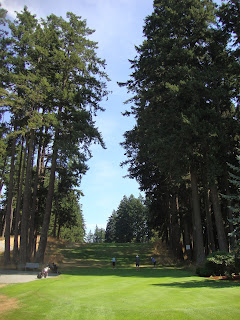Before volunteering for service in the 1st World War, Macan completed Royal Colwood. The old gem of a course is charming from start to finish. Its easy to see why so many people enjoy it so much here. Macan's clever routing is still evident, making use of the gently rolling terrain that covers most of the back 9.
Despite all of the great classic features of the course, it is not without fault. The most glaring are the bunkers, which (as of my last visit a few years ago) are in need of a restoration/renovation. This past summer I had the privilege of seeing the recent restoration work at Macan's nearby Victoria GC; if Royal Colwood had a similar bunker restoration, the course would be much more visually appealing and would play more true to the way I believe it was designed to play.
The first example of this is at the par 4 second hole. This beautiful 2-shot hole plays over the road that brings you into the club, and is guarded by bunkers down either side of the fairway. I believe these bunkers are supposed to prevent players from having a clear shot to the green, although they no longer present such a challenge.
 |
| Approaching the 2nd green. |
Holes 3 and 4 are flat, with greens guarded by a fronting stream. Many talk about them as though they are difficult holes, although I didn't find either to be overly challenging. The last of the flat holes is the par 5 5th, with a nice green complex. The round really gets going on the approach to the 6th hole. The uphill approach requires a carry over bunkers if you don't get your drive far down the fairway. The further your drive, the more the green opens up, and the easier the angle gets. Its a well designed hole which I think would benefit greatly from some bunker work.
 |
| Uphill approach to #6 after a mid-length drive |
 |
| The nice little 7th |
The 10th is, in my opinion, the most bland hole on the course, offering no memorable characteristics. The large net protecting the course from the driving range on the right also takes away from the appeal of the 10th, although it is necessary to prevent fatalities from stray range balls.
While there is little elevation in play on the par 3 11th, the hillside behind frames the hole and sets the stage for the rest of the back 9. This hillside must be carried from the 12th tee, likely one of the most picturesque spots on the course (thanks to the majestically mature trees lining the hole).
 |
| Disorienting height of trees on 12th tee |
 |
| Challenging 13th green (I'll try to capture it better when I return) |
 |
| 2nd shot to the par 5 14th - modern equipment allows an easy attack, but consider the intended layup options! |
From the furthest point on the course, the 15th starts the trek back to the clubhouse. Following this short par 3, the par 4 16th brings you back into one of the most beautifully wooded places on the course. Though quite short at 370 yds, I found the distances to be deceiving on this hole, likely due to the massive trees lining the fairway and surrounding the green. The setting makes you feel as small as an ant. In my opinion, one of the more underrated holes on the course!
 |
| Deceiving approach to the short 16th |
The closing tee shot is one of the most memorable on the course, and is a mirror image of the famous 18th at Riviera. From a lower level, the tee shot must carry to a raised fairway running gently to the left (whereas Riviera's 18th bends right). Worth noting: Royal Colwood celebrated it's 100 year anniversary in 2013, shortly before I played, making it 13 years older than Riviera - perhaps George C. Thomas took inspiration from this hole? Having played both, I can't argue with the fact that the American rendition is superior. I found the approach to be flat and lacking interest, which is a slightly disappointing way to end a fun round.
 |
| Riviera-like tee shot on #18 |
Having played all three of Macan's highly rated layouts in British Columbia, I've felt as though his courses have grown on me. With such experience I would offer this advice to anyone who may feel underwhelmed after playing a Macan course for the first time: try to play a second one; then play a third. Try to see more of his work. In doing so, pay close attention to how he incorporates the natural features of the land. As with other successful architects of the early 20th century, Macan created a lot of memorable holes without moving much earth. Many of those holes can be found at his first design.
'Til next time, keep your stick on the ice!
The Golfing Canuck


No comments:
Post a Comment